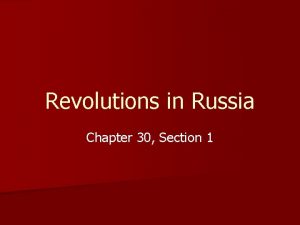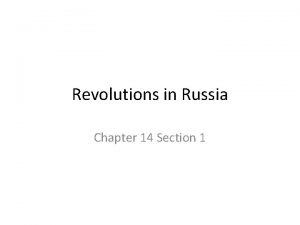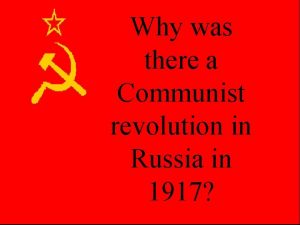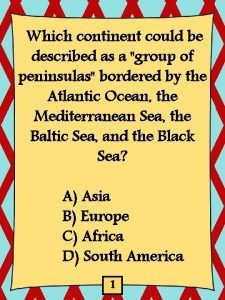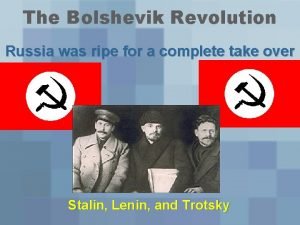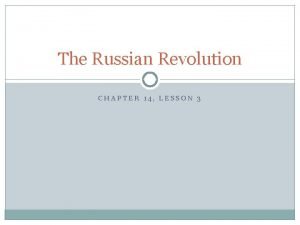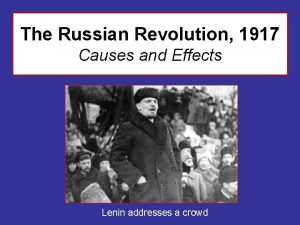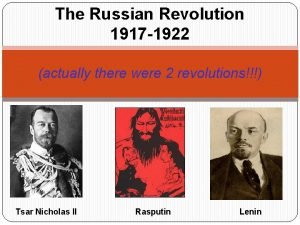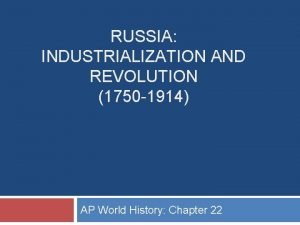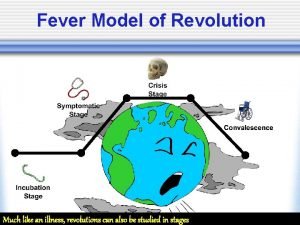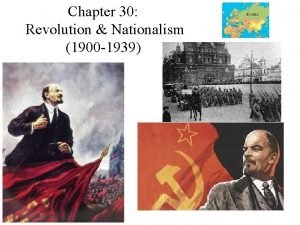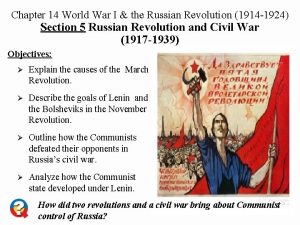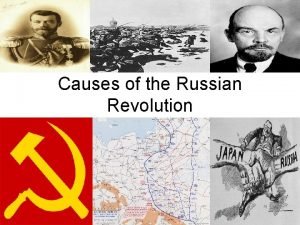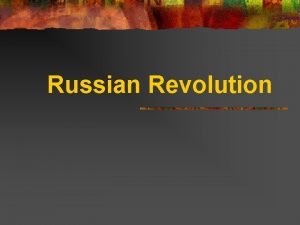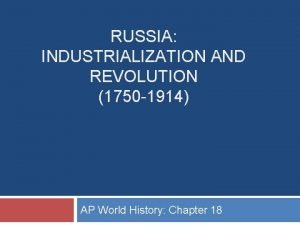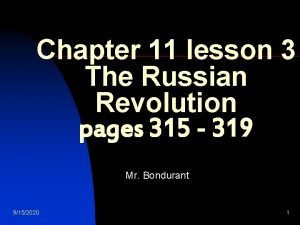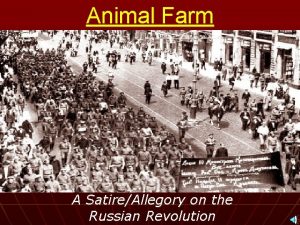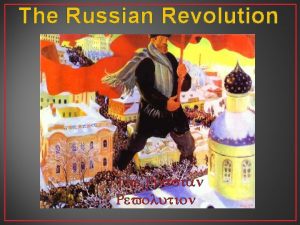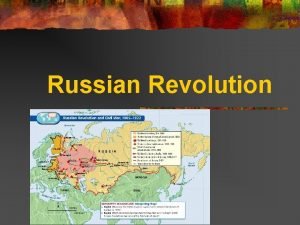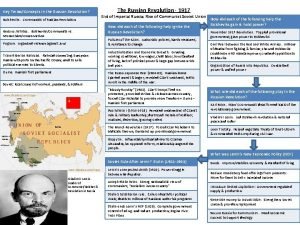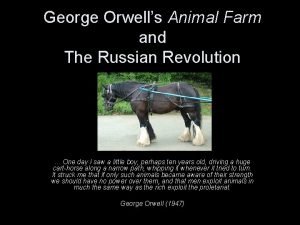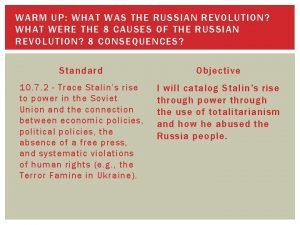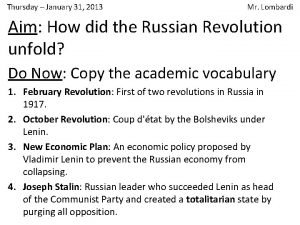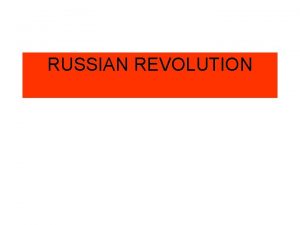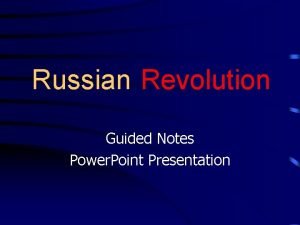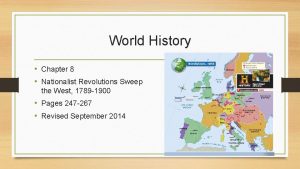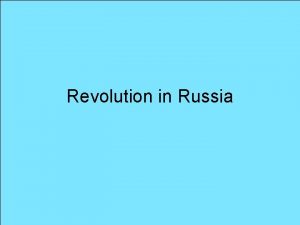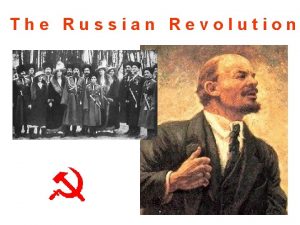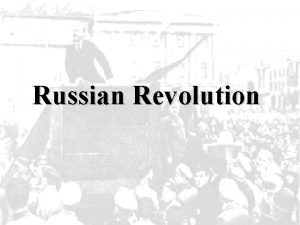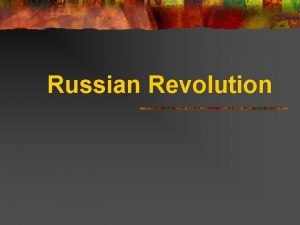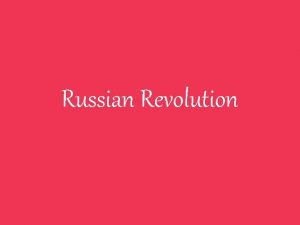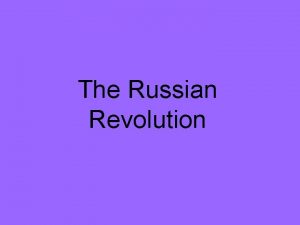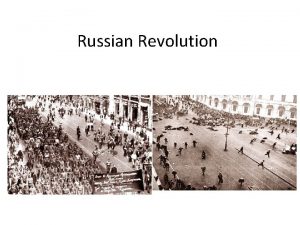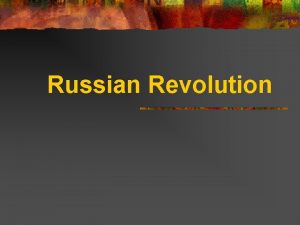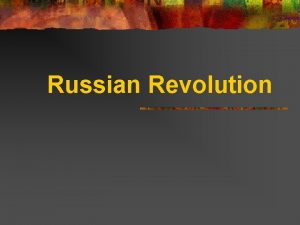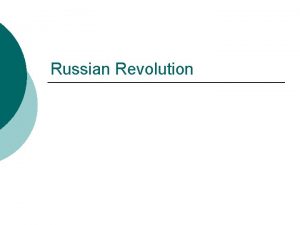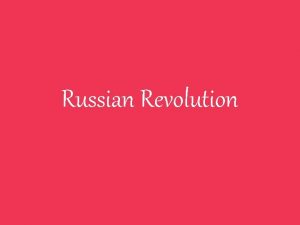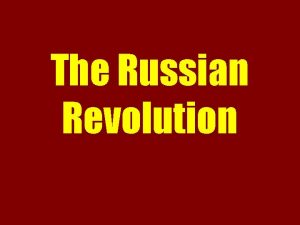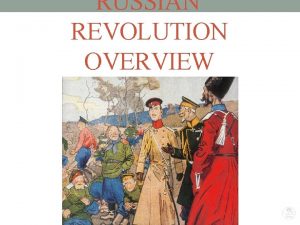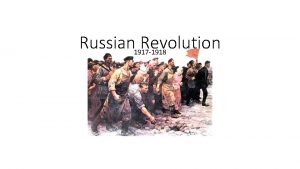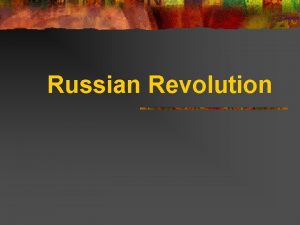Revolutions in Russia Introduction n The Russian Revolution

































- Slides: 33

Revolutions in Russia

Introduction n The Russian Revolution was like a firecracker with a very long fuse. The explosion came in 1917, yet the fuse had been burning for nearly a century. The cruel, oppressive rule of most 19 th-century czars caused widespread social unrest for decades. Army officers revolted in 1825. Secret revolutionary groups plotted to overthrow the government.

n In 1881, revolutionaries angry over the slow pace of political change assassinated the reform-minded czar, Alexander II. Russia was heading toward a full-scale revolution.

Czars Resist Change

End to Reform In 1881, Alexander III becomes czar and ends the reforms of his father, Alexander II. n Alexander III institutes autocratic rule, suppressing all opposition and decent. n

Czars Continue Autocratic Rule n Government censors written criticism; secret police monitor schools n Non-Russians living in Russia are treated harshly

Anti-Jewish Pogroms Jews become target of government backed pogroms (organized persecutions) n Alexander III encourages Jewish emigration to the United States during this time. The musical Fiddler on the Roof is set in this era. n

n In 1894, Nicholas II becomes czar and continues autocratic ways

Russia Industrializes

Rapid Industrialization n Number of factories doubles between 1863 and 1900, but Russia still lags behind other European countries. n In late 1800 s, new plan boosts steel production and a major railway begins

The Revolutionary Movement Grows Industrialization breeds discontent over working conditions and wages. n Growing popularity of Marxist idea that proletariat (workers) will rule n Bolsheviks—Marxists who favor revolution by a small committed group n

Lenin n Lenin—Bolshevik leader—an excellent organizer and inspiring leader

Crisis at Home and Abroad

The Russo-Japanese War n Defeat in the Russo-Japanese War in the early 1900 s causes unrest in Russia.

Bloody Sunday: The Revolution of 1905 In 1905, 200, 000 workers march on the czar’s palace to demand reforms n The army fires into the crowd, killing many n Massacre leads to widespread unrest; Nicholas if forced to make reforms n

The short lived Duma The Duma, Russia’s first parliament, meets in 1906 n Czar is unwilling to share power, dissolves the Duma after only 10 weeks n

World War I: The Final Blow n Heavy losses in World War I reveal government’s weakness n Nicholas goes to war front; Czarina Alexandra runs government in his absence

Czarina falls under the influence of Rasputin—a mysterious “holy man”— who she believes has the power to heal her son. n Nobles fear Rasputin’s influence and murder him n Army losing effectiveness; people at home are hungry and unhappy n

The March Revolution

First Steps In March 1917, strikes expand; soldiers refuse to fire on workers. n Most of the tension is caused by Nicholas II personally taking command of the military in World War I, and the war going so badly. n

The Czar Steps Down n March Revolution—protests become uprising; Nicholas abdicates throne n Duma establishes provisional, or temporary government n Soviets—committees of Socialist revolutionaries—control many cities

Lenin Returns to Russia n In April 1917, Germans aid Lenin in returning from exile to Russia (pictured in disguise with his goatee shaved and wearing a wig).

The Bolshevik Revolution

The Provisional Government Topples n In November 1917, workers take control of the government

Bolsheviks in Power n Lenin gives land to peasants, puts workers in control of factories n Bolsheviks sign treaty with Germany; Russia pulls out of World War I

Civil War Rages in Russia n Civil War between Bolsheviks’ Red Army and loosely allied White Army n Red Army wins three-year war that leaves 14 million dead

Comparing World Revolutions n Russian and French Revolutions are similar —both attempt to remake society and use violence against citizens who resist these changes.

Lenin Restores Order

New Economic Policy n In March 1921, Lenin launches New Economic Policy; has some capitalism n NEP and peace restore economy shattered by war and revolution n By 1928, Russia’s farms and factories are producing again

Political Reforms n Lenin creates self-governing republics under national government n In 1922, country renamed Union of Soviet Socialist Republics (U. S. S. R. ) n Communist Party—new name taken by Bolsheviks from the writings of Marx

Stalin Becomes Dictator

A New Leader Trotsky and Stalin compete to replace Lenin after Lenin’s death n Joseph Stalin— cold, hard Communist Party general secretary in 1922 n Leon Trotsky Joseph Stalin

n n Stalin gains power from 1922 to 1927 Lenin dies in 1924 Stalin gains complete power in 1928; Trotsky is forced into exile. Trotsky is murdered in Mexico City in 1940 by an NKVD agent. Room where Trotsky was murdered (above); Trotsky’s murderer, NKVD agent, Romón Mercader (right).
 Russian revolution vs french revolution
Russian revolution vs french revolution Revolutions in russia chapter 30 section 1
Revolutions in russia chapter 30 section 1 Chapter 14 section 1 revolutions in russia
Chapter 14 section 1 revolutions in russia Introduction of russian revolution
Introduction of russian revolution Which letter represents the pyrenees mountains on the map?
Which letter represents the pyrenees mountains on the map? There is a certain man in russia long ago
There is a certain man in russia long ago Why was russia ripe for revolution ww1
Why was russia ripe for revolution ww1 World war 1 and the russian revolution chapter 27
World war 1 and the russian revolution chapter 27 Chapter 14 lesson 3 the russian revolution
Chapter 14 lesson 3 the russian revolution Causes and effects of the russian revolution
Causes and effects of the russian revolution Czar in russian revolution
Czar in russian revolution How did vladimir lenin influence the russian revolution
How did vladimir lenin influence the russian revolution Russian industrialization ap world
Russian industrialization ap world Russian revolution political cartoons
Russian revolution political cartoons Fever model stages
Fever model stages Chapter 30 revolution and nationalism worksheet answers
Chapter 30 revolution and nationalism worksheet answers Chapter 14 world war 1 and the russian revolution
Chapter 14 world war 1 and the russian revolution Causes and effects of the russian revolution
Causes and effects of the russian revolution Http://www.history.com/topics/russian-revolution
Http://www.history.com/topics/russian-revolution Russian revolution of 1905 definition ap world history
Russian revolution of 1905 definition ap world history Chapter 11 lesson 3
Chapter 11 lesson 3 Triple alliance ap euro
Triple alliance ap euro How is animal farm a satire on the russian revolution
How is animal farm a satire on the russian revolution In the view of this cartoonist russia under
In the view of this cartoonist russia under The russian revolution
The russian revolution Russian revolution
Russian revolution The russian revolution
The russian revolution Russian revolution causes and effects
Russian revolution causes and effects Causes of the russian revolution
Causes of the russian revolution Russian revolution
Russian revolution Russian revolution guided notes
Russian revolution guided notes Could the french revolution have been avoided
Could the french revolution have been avoided Definition of third agricultural revolution
Definition of third agricultural revolution Chapter 8 nationalist revolutions sweep the west
Chapter 8 nationalist revolutions sweep the west

